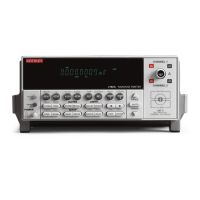C-4 Measurement Considerations
Minimizing thermal EMFs
To minimize thermal EMFs, use only copper wires, lugs, and test leads for the entire test
setup. Also, it is imperative that all connecting surfaces are kept clean and free of oxides. As
noted in Table C-1, copper-to-copper oxide junctions can result in thermal EMFs as high as
1mV/°C.
Even when low-thermal cables and connections are used, thermal EMFs can still be a
problem in some cases. It is especially important to keep the two materials forming the junction
at the same temperature. Keeping the two junctions close together is one way to minimize such
thermal problems. Also, keep all junctions away from air currents; in some cases, it may be
necessary to thermally insulate sensitive junctions to minimize temperature variations. When a
Cu–Cu connection is made, sufficient pressure must be applied to ensure the connection is gas
tight to prevent future oxidation.
In some cases, connecting the two thermal junctions together with good thermal contact to a
common heat sink may be required. Unfortunately, most good electrical insulators are poor
conductors of heat. In cases where such low thermal conductivity may be a problem, special
insulators that combine high electrical insulating properties with high thermal conductivity may
be used. Some examples of these materials include hard anodized aluminum, sapphire, and
diamond.
Nulling residual thermal offsets
Even if all reasonable precautions are taken, some residual thermal offsets may still be
present. These offsets can be minimized by using the Model 2182 Relative feature to null them
out. To do so, place the instrument on the 3mV range and short the end of the connecting cable
nearest the measured source (first disconnect the cable from the source to avoid shorting out the
source). After allowing the reading to settle, press the front panel REL button to null the offset.
Select the appropriate range, and make your measurement as usual.
If the offset voltage varies, the DC current-reversal technique should be used instead of REL.
The DC current-reversal technique requires a source that can output currents equal in magnitude
but opposite in polarity. In general, a voltage measurement is performed on both the positive and
negative alternations of the current source. The averaged difference of those two readings
cancels the thermal EMF component of the measurements. The Model 2182 can automatically
perform the measurements and calculate and display the result by using the Delta measurement
mode. See “Delta” in Section 5 for details.
Source resistance noise
Noise present in the source resistance is often the limiting factor in the ultimate resolution
and accuracy of Model 2182 measurements. The paragraphs below discuss the generation of
Johnson noise as well as ways to minimize such noise.

